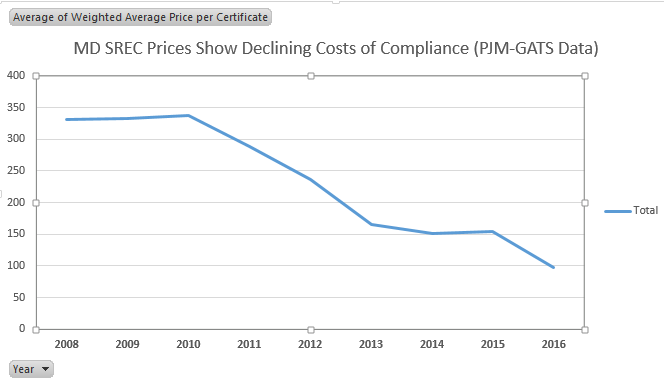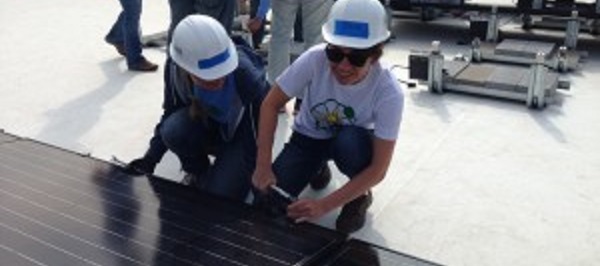According to the latest Solar Jobs Census, Maryland ranks #12 in solar jobs nationally, with nearly 4,300 solar workers cross the state. 40,485 homes were powered by solar as of The Solar Foundation’s latest report.
The growth of the Maryland solar market is largely due to the state’s renewable portfolio standard (RPS), which has created a strong, stable market for solar renewable energy credits (SRECs). Unlike other SREC markets – such as Pennsylvania and New Jersey – which have been volatile, boom, and bust, Maryland has benefitted from consistent growth year-over-year and a stable market for SRECs.
Moreover, high incentive levels in other “flashier” East Coast solar markets (e.g. Massachusetts, where we are offering $280/SREC for 5-year contracts in SREC I, $200 in SREC II) have historically led to relatively less representation by commercial and utility-scale solar developers in the state, again leading to a relatively stable supply-demand balance.
Maryland RPS = GOOD
The Maryland RPS has lived up to its promises. More than 1,000 solar jobs were added in Maryland last year alone. If market conditions stabilize (more on that below), solar employment will increase another 8.5% by the end of 2016, according to The Solar Foundation.
In addition to employment and solar deployment numbers that have come out of the Maryland RPS, it’s becoming increasingly easier and more affordable for utilities and energy suppliers to meet solar requirements set forth by the RPS. That’s because SREC prices, which utilities and energy suppliers must procure year-over-year to comply with the RPS, have steadily been declining.

The declining value of solar renewable energy credits makes it easier for utilities and energy suppliers to meet Maryland’s renewable energy goals. Credit: SolSystems
The Maryland Solar Market is at Risk
Unfortunately, however, this stable growth is at risk. Since the start of 2016, SREC prices in Maryland have taken a nose dive from $160/SREC and are now approaching the sub-$100. Price declines will continue, as previously unattainable utility-scale projects – which had a December 31, 2016 deadline before the extension of the solar investment tax credit (ITC) – will now move forward, disrupting the SREC market’s supply and demand balance. Moreover, the cost of solar has plummeted dramatically since the original passage of the RPS in 2004, and costs have continued to decline since its subsequent amendments. In fact, since 2010, the cost of a solar electric system has gone down by 70% according to the Sunshot Initiative. As costs of solar have come down, these goals need to be reevaluated to better reflect the growing demand for solar in the state.
Introducing the Maryland Clean Energy Jobs Bill
Currently, legislative action is pending to increase the Maryland RPS. HB 1106, also known as the Maryland Clean Energy Jobs Bill, calls for a modest increase in the solar carve-out provision with the RPS, pushing it from 2% by 2020 to 2.5% by 2020, and pushing the overall renewables requirement to 25% of electricity by 2025. This will essentially require more than 500MWdc of solar. This is an attainable RPS goal that the solar industry is expected to meet with ease.
This slight increase in near-term demand for solar is offset by reduced Solar Alternative Compliance Payments (SACPs), which essentially act as a price ceiling for the SREC market. Moreover, this increase is modest in comparison to other states such as Oregon and California which recently passed 50% RPS bills. Maryland’s neighbor, D.C., also proposed a 50% RPS last week.
Moreover, the Clean Energy Jobs Act of 2016 will support pre-apprenticeship, apprenticeship, and other workforce programs to establish career pathways within the renewable energy industry. (As a company that’s been hiring constantly over the last several years, we’d appreciate being able to find more local talent with ease.)
Will the Clean Energy Jobs Bill Affect SREC Prices?
While the Clean Energy Jobs bill will not have a dramatic upward push on SREC prices, the bill’s successful passage could possibly bring SREC prices back to where they were, closer to $120 for 2017, and to $85 for 2018. HB 1106 was heard in the Maryland House Economic Matters Committee on 3/3.
Its corresponding bill in the Senate will be heard in committee today, Tuesday, March 8. Tell your state legislators that you want to see more solar in Maryland by doing by clicking on MDV-SEIA’s Action Alert, or by calling your state legislator.











Comments